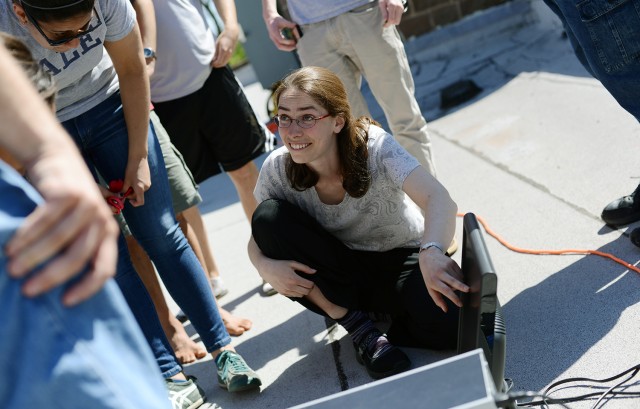Hughes, Colleagues Investigate “Planetary Construction Site”

A curious mix of dust and gas surrounding a distant star presents a unique mystery – and possibly a front-row seat to planet formation, according to Assistant Professor of Astronomy Meredith Hughes and colleagues, whose paper on the star appears in the March 6 edition of the journal Science.
The group of astronomers, including Hughes and 13 others, were the first to identify the asymmetry and “lumpy” quality of the gas surrounding beta Pictoris, using data from the Atacama Large Millimeter/Submillimeter Array (ALMA) in Chile. The discovery leads to two possible explanations: There may be a giant “exoplanet” lurking nearby (forcing clumps of carbon dioxide to orbit the star on opposite sides) or there has recently been a collision between two Mars-sized bodies. More data must be analyzed to figure out which event happened.
“We actually already knew that there was gas around this star, but we didn’t know how much, or that the gas would be lumpy and asymmetric – the asymmetry is another indication that the gas was probably generated by a recent collision,” explained Hughes.
Beta Pictoris, which is actually a stellar neighbor of Earth, about 60 light years away, is in an active place for planet formation, Hughes said. And the evidence discussed in the Science paper points toward very recent (on astronomical timescales – in this case probably thousands of years) events.
“The phrase that gets tossed around a lot in these observations is ‘planetary construction zone,’ and that is very apt in this case,” she said.
The astronomers’ work represents some of the first data from ALMA, the most powerful radio telescope ever built. Previous telescopes were not powerful enough to observe the gas.
The observations were made when only a small fraction of the telescope was operational, “so it’s incredibly exciting to imagine the new phenomena we’ll see as the array reaches full strength,” Hughes said. “This is really just the tip of the iceberg.”
Hughes is still working on the puzzle. She recently got the first delivery of her own ALMA data that studies mysterious carbon monoxide orbiting around another energetic nearby star. She’s also planning to use the beta Pictoris data and new information that will be taken this summer to look at the dusty debris around the star, and measure how much mass is hiding there.
The lead investigator on the paper was William Dent, system astronomer for ALMA. Hughes and 12 others contributed. The journal Science, with an estimated 1 million readers worldwide, covers every scientific discipline and is extremely selective; about only 10 percent of submitted papers are published.
Hughes was this week awarded a NASA Space Grant for curriculum development to support her project of building a new telescope at Wesleyan, this one capable of detecting the Cosmic Microwave Background – what astronomers call the afterglow of the Big Bang.
Students in her radio astronomy class next semester will get to work on both the design and construction of a telescope to tease out that weak signal from all the noise in the sky.
“Radio astronomy was one of the first courses I taught at Wesleyan, and it’s one of my favorites because it lets me introduce our upper-level students to a totally novel way of thinking about astronomy,” Hughes said. “The grant will provide an opportunity to more closely integrate instrumentation work into the lecture material, and the telescope we create will allow future generations of Wesleyan students to observe the sky in a new way.”
Hughes said the new telescope is “very complementary” to the one her first group of students built, which is permanently installed on the roof of Van Vleck Observatory.
Read more about Hughes’ research on planetary system formation in this past Wesleyan Connection article.

